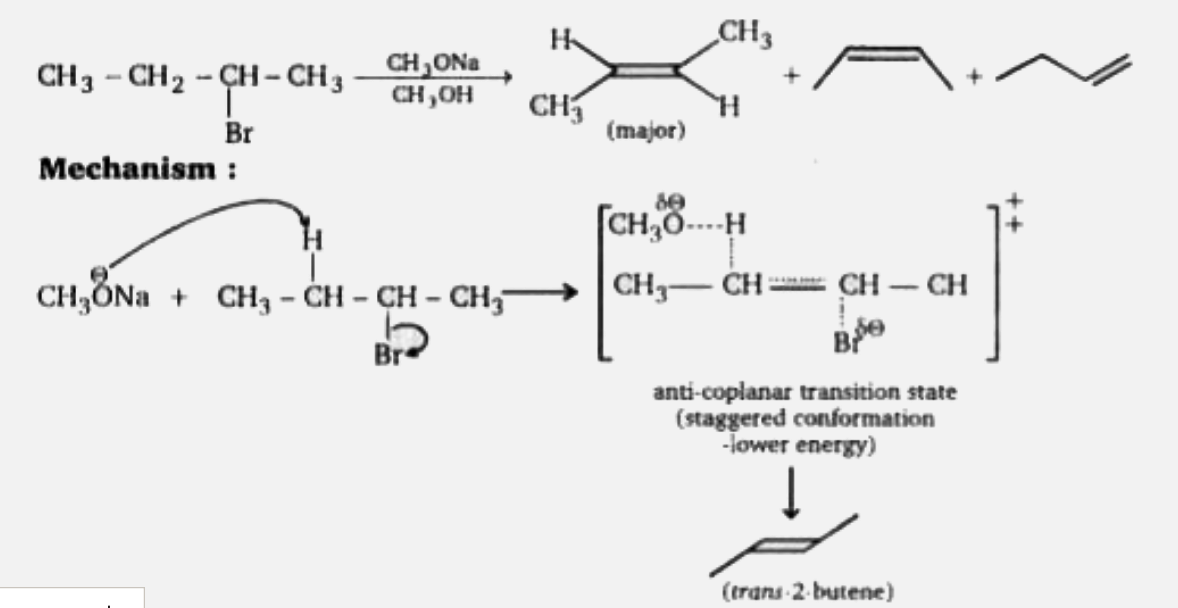Ph−O∣∣C−CH3NaNO2−−−−→HCl(A)AC2O−−→heat(B)H3O+−−−→(C)
Product ( C) of the above reaction is :Solution in Telugu
Ph−CO2H
Ph−O∣∣C−CO2H
Ph−O∣∣C−O∣∣C−H
Ph−O∣∣C−CH2OH
The correct Answer is:B
Topper's Solved these Questions
- ALDEHYDES AND KETONESBOOK - MS CHOUHANCHAPTER - ALDEHYDES AND KETONESEXERCISE - LEVEL-2
20 Videos
- ALCOHOL,ETHERS AND EPOXIDESBOOK - MS CHOUHANCHAPTER - ALCOHOL,ETHERS AND EPOXIDESEXERCISE - SUBJECTIVE PROBLEMS
1 Videos
- ALKYL HALIDES (ELIMINATION REACTION) BOOK - MS CHOUHANCHAPTER - ALKYL HALIDES (ELIMINATION REACTION) EXERCISE - LEVEL-2
25 Videos
Similar Questions
Select the best choice for example (A to L) from the examples (a to n) given below. Write your choice in the box given.


View Solution
Maximum number of moles of Ac2O consumed by reactant (A) is :
View SolutionComprehension
E2 raction → Elimination bimolecular
In the general mechanism of the E2 reaction a strong base abstract a proton on a carbon atom adjacent to the one of the leaving group. As the abstracts a proton , a double bond forms and the leaving group leaves.

Identify the rate ofreaction of given compounds in E2 reaction:

View SolutionCH_(3)-(CH_(2))_(3)-OH overset(CH_(3)-underset(O)underset(||)overset(O)overset(||)(S)-Cl)underset(ET_(3)N)(rarr)(A) overset(14)overset(KCN)(rarr)(B) overset(H_(3)O^(o+))(rarr)(C) Product (C) is :
View SolutionH_(3)C-overset(O)overset("||")C-O-underset(Ph)underset(|)C=CH_(2)+H_(2)O overset(NaOH)underset(H_(3)^(oplus)O)rarrX+Y X and Y are:
View SolutionChoose the correct case of hydrolysis for the following molecules : (P) CH_(3)-overset(O)overset("||")C-OCPh_(3) (Q) CH_(3)-underset(CH_(3))underset(|)CH-overset(O)overset("||")C-O-CPh_(3) (R) Ph-underset(CH_(3))underset(|)CH-overset(O)overset("||")C-O-CPh_(3) (S) CH_(3)CH_(2)-underset(CH_(3))underset(|)CH-overset(O)overset("||")C-O-CPh_(3)
View SolutionPh-overset(O)overset(||)(C)-CH_(3) overset(NaNO_(2))underset(HCl)(to) (A) underset("heat")overset(AC_(2)O)(to) (B)overset(H_(3)O^(+))(to)(C) Product (C) of the above reaction is :
View SolutionHOCH2CH2CH2−O∣∣C−OCH2CH3PCC−−→(A)H2C=CHMgBr−−−−−−−−−−−−−→(1molar equivalent)(B)NH4Cl/H2O−−−−−−−→(C)KOH−−−−−→H2OH3O⊕−−−→⎛⎜ ⎜ ⎜⎝CH3−O∣∣C⎞⎟ ⎟ ⎟⎠2O−−−−−−−−−−−−→Pyridine(D)
Product (D) is :
View SolutionCH_(3)CH_(2)-overset(O)overset(||)(C)-CH_(3) overset(NaNO_(2))underset(HCl)(to) , Major product of this reaction is :
View SolutionCH_(3)-overset(O)overset(||)(C)-CH_(2)-CH_(2)-overset(O)overset(||)(C)-CH_(3) overset((NH_(4))_(2)CO_(3))underset(Delta) to (A) overset(C Cl_(3) CO_(2)Na) underset(Delta) to underset(("major"))((B)) Product (B) of above reaction is :
View SolutionCH_(3)-overset(O)overset(||)(C)-CH_(2)-underset(CH_(3))underset(|)overset(CH_(3))overset(|)(C)-CHOoverset(KOH,H_(2)O)to(A) , product A is
View SolutionArrange the following compounds in decreasing order of nucleophilic addition reaction : CH3−O∣∣CI−CH3 CH3−O∣∣CII−Cl CH3−O∣∣CIII−OH CH3−O∣∣CIV−NH2 CH3−O∣∣C−OV−O∣∣C−CH3
View SolutionPh−O∣∣C−CH3NaNO2−−−−−→HCl(A)AC2O−−−−−→heat(B)H3O+−−−→(C)
Product (C) of the above reaction is :
View SolutionThe correct stability order of the following resonanating structures is :
CH2=C=O(I) C3−C−+C=O(II) H2C=+C−−O(III) H2−C−C≡+O(IV)
View SolutionCH3−O∣∣C−O−HNaH14CO3−−−−−→(A)(gas)(i)PhMgBr−−−−−−−→(ii)H3O⊕(B)
CH3−O∣∣S∣∣O−O−HNaH14CO3−−−−−→(C)gas(i)PhMgBr−−−−−−−→(ii)H3O⊕(D)
Product (B) and (D) in the above reaction are :
View SolutionPh−O∣∣C−CH3NaNO2−−−−→HCl(A)AC2O−−→heat(B)H3O+−−−→(C)
Product ( C) of the above reaction is :
View Solution

